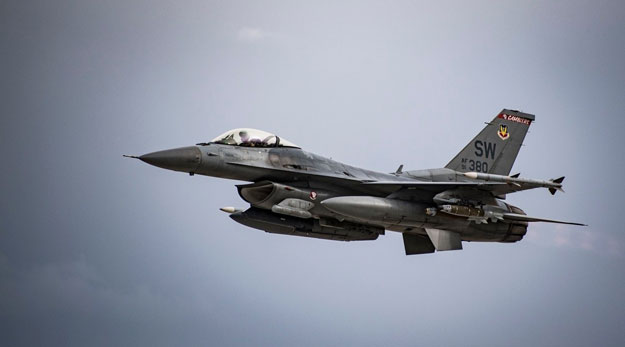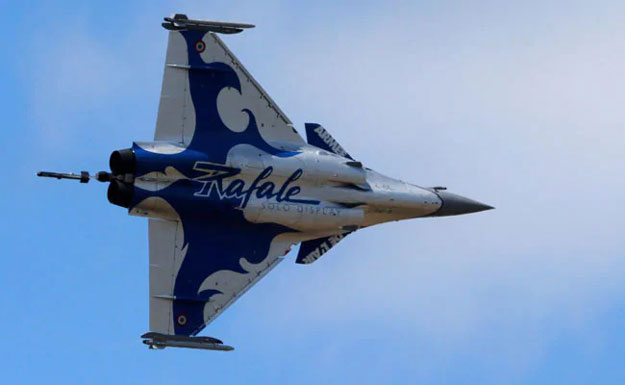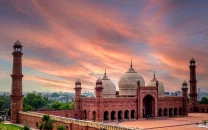Desperate to clinch lucrative India deal, Lockheed rebrands F-16
Company offers to build F-21 exclusively for Indian air force

Company offers to build F-21 exclusively for Indian air force. PHOTO: FILE
Perhaps Lockheed Martin sales team had this mantra in mind in its latest bid to win an ongoing competition to supply India’s air force with over a hundred fighter jets.
Seemingly desperate to sell its aging but still highly capable F-16 to India, the American aerospace and defence firm has rebranded the venerable workhorse as the ‘F-21’ to pitch it as a ‘completely new design’.
As it unveiled the F-21 at an air show in Bengaluru on Wednesday, Lockheed claimed it was offering India a completely new aircraft which would be uniquely configured to the country’s air defence needs and come equipped with technologies borrowed from American fifth generation fighters, namely the F-22 and F-35.
“The F-21 is different, inside and out,” Lockheed Martin Aeronautics Strategy and Business Development vice president Vivek Lall said in a statement released by the firm. “It is a different animal [from the F-16],” he was quoted by India’s Economic Times as saying.
Aman-19: Pakistan Navy's expanding influence
Lockheed’s Business Development Director Randall Howard added that the F-21 will be offered “only to India and no other nation.”
Advertised with the tag line “For India. From India,” the company has offered to build the plane in collaboration with India’s Tata Advanced Systems. For a contract that could amount to as much as $15 billion for the winner, Lockheed’s offering will go up against Boeing’s F/A-18E/F Super Hornet, the Gripen offered by Saab of Sweden, the Dassault Rafale, the Eurofighter Typhoon and an as yet unknown offering from Russia.
“Like any other company, Lockheed is interested in selling its product,” said defence analyst Dr Ayesha Siddiqa while commenting on the US firm’s rebranding attempt. “India has a huge defence budget and its military has a corresponding demand for military hardware. All major defence suppliers want a slice.”
“The Indian Air Force desperately wants to add not only new technology but numbers,” said Air Vice Marshal (retd) Ikramullah Bhatti. “Naturally, the world’s leading manufacturers want a foothold in the Indian market,” he added.
That is not all, however. According to AVM (retd) Bhatti, Lockheed wants to move on to producing the fifth generation F-35 in numbers. But at the same time, it wants to capitalise on the huge investment in the F-16 that it has made
“An Indian order for over a hundred planes represents a huge opportunity for Lockheed. However, they have learnt that it would be a hard sell if they stick to the F-16 brand,” he said. “The F-16 is indeed an old design, it first entered service in 1979. Lockheed tried to sell India a customised variant before, but failed.”

“In that respect, it is well considered move to rebrand it as the F-21,” AVM (retd) Bhatti said. “That being said, I am sure the Indians are intelligent enough to see through this move.”
Dr Siddiqa, meanwhile, suggested that current geopolitical tensions will be a factor in the competition. “Lockheed and other suppliers will try to use the tension over the Pulwama attack to their advantage,” she said.
“There is anger in the Indian public and in the Indian military over Pulwama. Meanwhile, India’s defence spending has gone down over the past couple of years and its air force keeps hemorrhaging its aging fleet,” she said. “There will be more anger, both in the public and within military circles if he fails to complete a deal.”
“It definitely is a testing time for Indian procurement and a lot will affect the quality of the country’s final decision,” she added.
Lockheed previously pitched the F-16 – used by 26 air forces worldwide, including that of Pakistan – for a competition to supply India with 126 fighter jets. While France’s Dassault won that contract with its Rafale jet, protracted and troublesome negotiations over local production resulted in India purchasing merely 36 of the type.
AVM (retd) Bhatti believes the Rafale is likely to come out on top again, albeit with new terms offered by Dassault. One reason he cited is India’s already diverse fleet.
“With so many aircraft types with similar capabilities, the IAF faces a very serious logistics handicap,” he said. “And they are aware of this.”
“This is why the IAF would want to restrict its supply chains to France and Russia,” he added.
AVM (retd) Bhatti also said the capabilities the Rafale provides over the F-16 is another factor in the French aircraft’s favour. “Historically, Pakistan has had a technological edge over India, albeit a limited one due to numbers,” he told The Express Tribune. “The Rafale will erode that edge.”

When it pitched the type earlier, Lockheed offered to move its F-16 production operation from its plant at Fort Worth, Texas to India. Lockheed had hoped to export F-16s from India to other countries while meeting Prime Minister Narendra Modi’s demand for domestic production to increase his country’s military industrial capabilities.
The Indian military, however, rejected Lockheed’s offer early on in the competition and eventually settled on the French as their preferred supplier. At the time, Indian officials cited the age of the F-16 design – even though Lockheed had proposed to develop a bespoke Block 70 version for it – as well as inadequate transfer of technology as reasons for rejecting the offer. Observers, however, suggested that Pakistan’s long use of the type as a mainstay in its air force also stigmatised it for Indian defence planners.
Dr Siddiqa criticised India’s obsession with local production of military hardware. “Transfer of technology is a big waste of time,” she said. “Until you have an economy of scale, the capacity to produce more or upgrade is unavailable even if you have the technology.”
“Instead of transfer of technology, I would have negotiated a better contract for spares,” she added.
That being said, on the off chance that India does decide to go with Lockheed’s offer, it could pose a huge setback to Pakistan’s current procurement.
“On a symbolic level, it would definitely be a shock, initially at least,” said Dr Siddiqa. “Politically, Pakistan will argue the US has upset the balance of power in the region. India did when we got our first F-16s in the ’80s.”
In the longer run, if India is set up as the sole hub for F-16 production and spares, Pakistan’s ability to keep the type in the air might be affected as well, she said. “The F-16 is perhaps the finest aircraft the Americans created. Against a JF-17, I would go with an F-16 anytime.”
Dr Siddiqa did point out a silver lining, though. “Pakistan has had a long experience with the F-16. If, once the shock subsides, we put out heads together, we will realise we know the type’s ins and outs better.”





1675249047-0/image-(18)1675249047-0-208x130.webp)













COMMENTS
Comments are moderated and generally will be posted if they are on-topic and not abusive.
For more information, please see our Comments FAQ